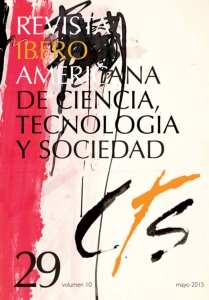CYTED
a progressive bet on the funding of science and technology in Ibero-America?
DOI:
https://doi.org/10.52712/issn.1850-0013-521Keywords:
CYTED, Ibero-America, scientific technological cooperation, progressiveness, I D iAbstract
The Ibero-American Science and Technology for Development program (CYTED, as per its Spanish acronym) is a multilateral initiative that promotes and supports cooperation in research, development and innovation (R&D&I) in the Ibero-American region. A distributive “progressive” strategy (in financing as well as in the allocation of resources) should contribute to bridge the existing gap between the different innovation capacities in the Ibero-American countries. In order to verify this hypothesis we carried out a distributive analysis that reveals the insufficient aggregate progressiveness of the CYTED program (mainly due to the regressive participation of Latin American countries with medium to high innovation capacities). Therefore, we offer practical recommendations to improve this situation.
Downloads
References
BANCO MUNDIAL (2013): World Development Indicators, Washington DC. Disponible en: http://databank.worldbank.org/data/home.aspx.
BAULCH, B. (2006): “Aid distribution and the MDGs”, World Development, nº 34, vol. 6: pp. 933-950.
CLARK, D. (1991): “Trade versus aid: distributions of third world development assistance”, Economic Development and Cultural Change, vol. 38, pp. 829–837.
CLARK, D. (1992): “Distributions of official development assistance among developing country aid recipients”, The Developing Economies, vol. 30, nº 3, pp. 189–197.
CYTED (s/f): Informes anuales para la SEGIB del Programa Iberoamericano de Ciencia y Tecnología para el Desarrollo (CYTED). Disponibles en: http://segib.org/es/node/2962.
KAKWANI, N. C. (1977): “Measurement of tax progressivity: an international comparison”, Economic Journal, vol. 87, nº 345, pp. 71–80.
MCGILLIVRAY, M. (2004): “Descriptive and prescriptive analysis of aid allocations. Approaches, issues and consequences”, International Review of Economics & Finance, vol. 13, nº 3, pp. 275-292.
MOSLEY, P. (1987): Overseas aid: its defence and reform, Brighton, Wheatsheaf Books.
MURPHY, L. y NAGEL, T. (2002): The Myth of Ownership: Taxes and Justice, Oxford, Oxford University Press.
QUIÑONES, A. y TEZANOS, S. (2011): “Ayuda Oficial al Desarrollo Científico- Tecnológica: una evaluación macroeconómica de la distribución geográfica y sectorial”, Revista de Economía Mundial, vol. 29, pp. 153-179.
RICYT (2013): Indicadores on-line. Disponibles en: http://www.ricyt.org/index.php? option=com_content&view=article&id=149&Itemid=3.
SEGIB (2005): Declaración de Salamanca, XV Cumbre Iberoamericana de Jefes de Estado y de Gobierno, Salamanca. Disponible en: http://segib.org/documentos/esp/ Declaracion%20de%20Salamanca.pdf.
SUITS, D.B. (1977): “Measurement of Tax Progressivity”, American Economic Review, vol. 67, nº4, pp. 747–752.
TEZANOS, S. (2008a): Cooperación para el desarrollo. Asignación geográfica de la ayuda española, Madrid, Biblioteca Nueva.
TEZANOS, S. (2008b): “Modelos teóricos y empíricos de asignación geográfica de la ayuda al desarrollo”, Principios, Estudios de Economía Política, vol. 10, pp. 5-41.
TEZANOS, S. (2010): “Geopolítica de la ayuda. Un mapa estratégico para la cooperación del siglo XXI”, en A. Guerra, J.F. Tezanos y S. Tezanos (eds.): La lucha contra el hambre y la pobreza, pp. 369-414, Madrid, Editorial SISTEMA.
TEZANOS, S. (2012): “¿Es progresiva la financiación internacional de la ayuda pública para el desarrollo?”, Boletín de Información Comercial Española, vol. 3026, pp. 11-21.
WHITE, H. y MCGILLIVRAY, M. (1995): “How well is aid allocated? Descriptive measures of aid allocation”, Development and Change, vol. 26, pp. 163–183.
Downloads
Published
How to Cite
Issue
Section
License
Copyright (c) 2023 CC Attribution 4.0

This work is licensed under a Creative Commons Attribution 4.0 International License.
All CTS's issues and academic articles are under a CC-BY license.
Since 2007, CTS has provided open and free access to all its contents, including the complete archive of its quarterly edition and the different products presented in its electronic platform. This decision is based on the belief that offering free access to published materials helps to build a greater and better exchange of knowledge.
In turn, for the quarterly edition, CTS allows institutional and thematic repositories, as well as personal web pages, to self-archive articles in their post-print or editorial version, immediately after the publication of the final version of each issue and under the condition that a link to the original source will be incorporated into the self-archive.











